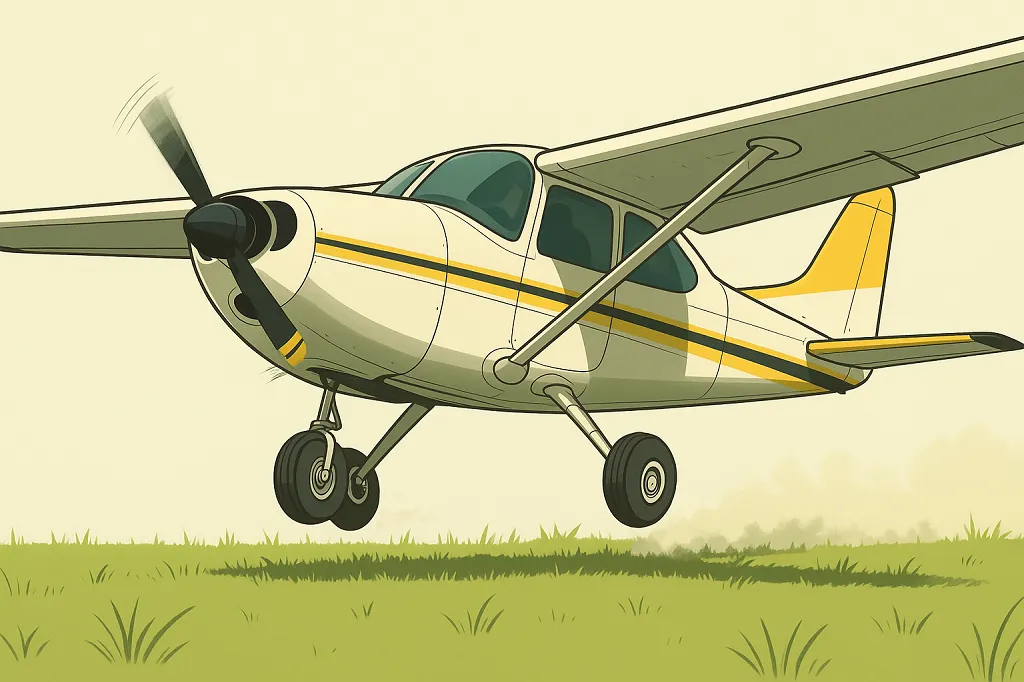Why Soft Field Landing Skills Can Save Your Life
Let’s face it: many pilots underestimate the challenges of soft field landings. A seemingly routine grass strip can quickly become hazardous without the proper techniques. This isn’t just about passing a checkride; it’s about significantly expanding your flying options and prioritizing safety. Mastering soft field landings opens a world of backcountry strips and charming small airports, enriching your flying experience.
Landing on a soft field presents unique challenges due to decreased friction compared to paved runways. This reduced friction impacts both landing and takeoff performance. It demands a different approach than landing on pavement. On pavement, the lower rolling resistance means your aircraft decelerates more slowly after touchdown, requiring a longer rollout.
Additionally, the yielding nature of grass or mud increases the risk of wheels sinking or getting stuck. This is where soft field landing techniques become paramount. These techniques minimize that risk and maintain control, enabling safe landings and takeoffs in less-than-ideal conditions.
The importance of soft field landings in aviation safety can’t be overstated. They are crucial for pilots operating in environments with suboptimal runway conditions, such as grass or mud. The FAA emphasizes using full flaps to achieve a slow touchdown speed, maximizing the aircraft’s ability to remain airborne. This allows for better control and the option to abort the landing if necessary. Historically, these techniques have been a cornerstone of flight training. The FAA requires proficiency in these skills for flight reviews under FAR 61.56(c). (Explore this topic further: Going Soft)
Understanding the Dynamics of Soft Fields
The physics behind soft field landings are straightforward. When your wheels touch down on a soft surface, they sink, creating drag and increasing the risk of a nose-over. Understanding this is crucial for incident prevention.
Mastering these landings requires understanding the aerodynamic principles that provide control. Maintaining the correct attitude and airspeed is essential for a safe touchdown. This means controlling your descent rate and using the aircraft’s lift to your advantage. Mastering these techniques allows you to transition from avoiding grass strips to confidently embracing the opportunities they offer. This knowledge distinguishes confident pilots from those hesitant to utilize these airfields.
Reading The Field Like A Pro
The difference between a smooth landing and a costly mistake often comes down to your observations during the approach. Experienced pilots understand that successful soft field operations begin with careful assessment. This means learning to interpret the visual cues that reveal surface conditions, moisture levels, and potential hazards.
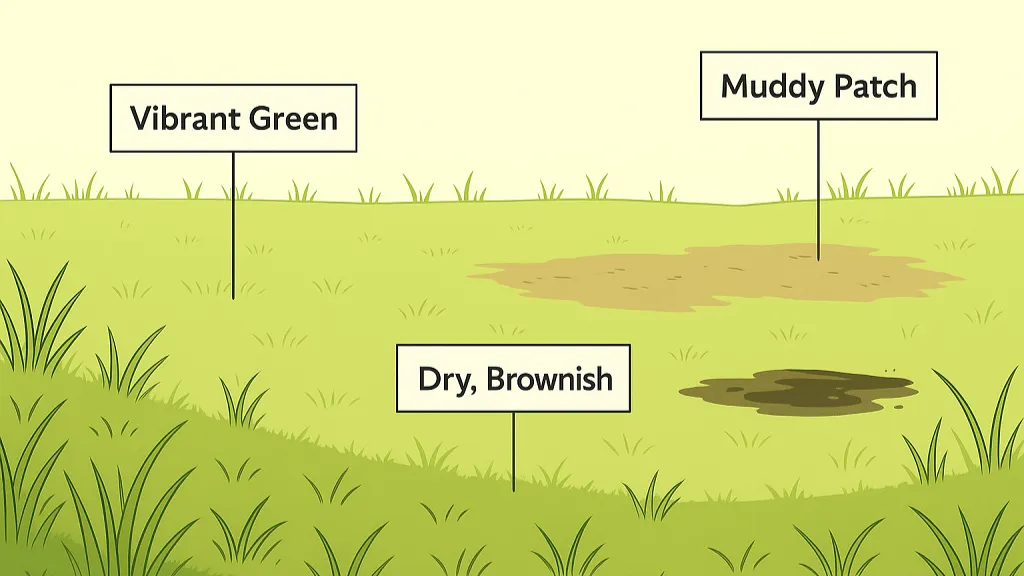
For example, the color of the grass can be very telling. Vibrant green suggests moisture and potential softness, while a duller, brownish hue may indicate a firmer, drier surface.
Visual Cues and Runway Evaluation
Seasoned bush pilots use systematic runway evaluation techniques. These involve observing the field from various angles during the approach. They look for changes in color, texture, and vegetation that might reveal soft spots or hidden obstacles. This careful observation is much like a detective examining a crime scene, searching for subtle clues.
Also, consider the surrounding terrain. Low-lying areas or those near water are more likely to hold moisture and become soft. Knowing this can help you anticipate potential problem areas before you commit to landing.
Grass Type: Long grass can create drag and be misleading about the actual firmness of the ground below. Short, tightly packed grass typically offers better landing conditions.
Surface Irregularities: Look for ruts, mounds, or animal burrows that could be dangerous during your rollout.
Moisture Levels: Watch for standing water or areas that appear darker and more saturated, which indicate potential softness.
Weather’s Lingering Impact
Weather patterns greatly influence field conditions, even days after a storm. Heavy rain can saturate the ground, creating deceptively soft areas that might not be readily visible. A field that seemed suitable a few days earlier could now be much softer.
However, a period of strong winds can help dry the surface faster, lessening the concern of a recent downpour. Learning to interpret these weather patterns is essential for safe soft field operations.
Gathering Intelligence Before You Commit
Before committing to a landing on an unfamiliar strip, collect as much information as you can. Talk to local pilots, check online resources, or even request a fly-by to personally assess the field’s condition. This proactive approach can prevent an unpleasant surprise.
This pre-landing assessment is especially vital for strips without published information or those known for difficult conditions. Making careful observation a habit will considerably improve your decision-making during soft field operations.

The Step-By-Step Technique
Forget the textbook theories; this section reveals how experienced pilots consistently achieve safe soft field landings. We’ll break down each phase, from the initial approach setup to the final rollout, offering practical tips and techniques. This detailed approach will give you the knowledge to confidently handle soft field landings.
Approach Configuration: Setting the Stage
The initial approach configuration is the foundation of a successful landing. Begin by selecting the appropriate flap setting for your aircraft. Typically, full flaps are used to maximize lift and drag, allowing for a slower approach speed while maintaining control.
Also, establish a stable approach speed slightly above your aircraft’s stall speed. This delicate balance prevents a stall while allowing for a slower touchdown.
Power Management: Maintaining Control
Precise power management is crucial throughout the entire soft field landing process. Maintain enough power to control your descent rate without using so much that you float above the runway.
As you near the runway threshold, gradually reduce power while holding your approach speed and attitude. This controlled reduction prevents a rapid sink rate and keeps you on your glide path. A stabilized approach and controlled airspeed are key factors in successful soft field landings.
Flare and Touchdown: The Critical Moment
Timing is everything during the flare. Begin the flare slightly earlier than you would on a paved runway. This allows the aircraft to settle gently onto the softer surface, minimizing the impact.
Maintaining the correct attitude is critical during touchdown as the runway surface can grab your wheels. The sensation is akin to landing on a very large, slightly deflated bouncy castle; a gentle approach prevents any sudden jolts.
Rollout and Braking: Bringing It to a Stop
Upon touchdown, keep the nose wheel slightly raised. This minimizes drag and allows the main landing gear to absorb the initial impact of the soft surface.
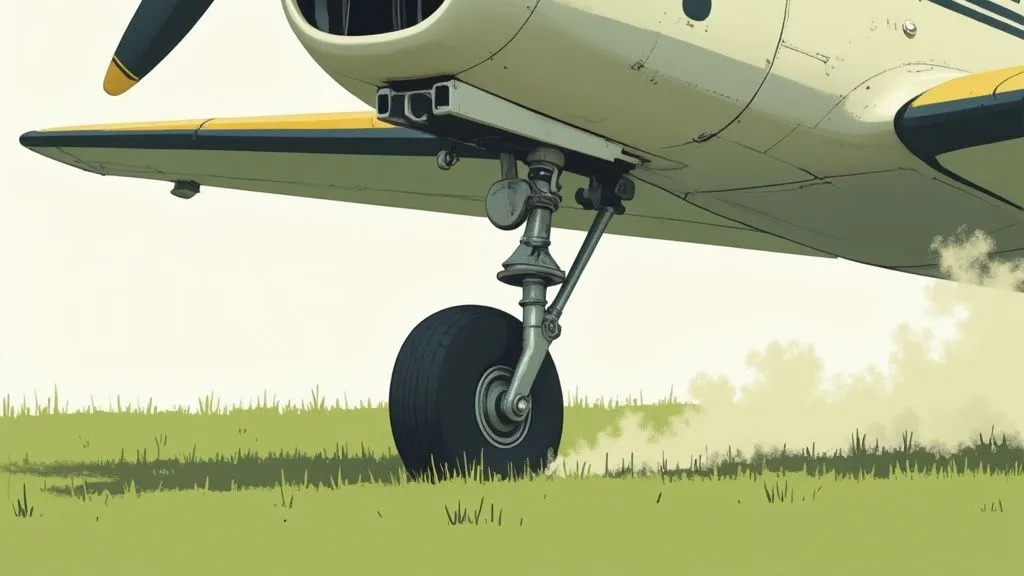
Apply gentle braking pressure as needed. Remember, braking effectiveness is reduced on a soft field, similar to braking on a wet or icy road. However, due to higher rolling resistance, you’ll generally need less braking than you would on a paved surface, so it’s important to find the right balance. Finally, maintain directional control by using rudder inputs to counteract any crosswind effects, ensuring a straight rollout.
Tailoring Techniques To Your Aircraft Type
Every aircraft handles differently, especially on soft fields. Ignoring these differences, whether you’re flying a Cessna 172 or a Piper Cherokee, can lead to trouble. Different aircraft have varying characteristics, from high-wing trainers to low-wing aircraft, which influence soft field performance. These nuances significantly impact your approach to a soft field landing.
High-Wing Vs. Low-Wing Considerations
High-wing aircraft, like the Cessna 172, experience ground effect more intensely than their low-wing counterparts. This cushion of air can extend the float during the flare, a benefit during soft field landings. However, it can also cause you to float further down the runway than planned.
Low-wing aircraft, experiencing less ground effect, are less prone to floating. This necessitates a more precise approach and touchdown. This seemingly small difference underscores the importance of understanding your aircraft’s specific handling qualities.
Soft field landing training is crucial for pilots worldwide. Aircraft like the Helio H295 even have dedicated procedures for these operations, emphasizing a slow, controlled touchdown. This focus on proper technique is not just about safety; it’s also about efficiency, enabling pilots to handle diverse runway conditions. The demand for this specialized training continues to rise, especially during summer months when grass strips become more common.
Weight and Balance: A Critical Factor
Weight and balance significantly influence soft field landings. A heavier aircraft demands a higher approach speed, increasing landing rollout and the risk of sinking into the soft surface. Incorrect center of gravity can also complicate aircraft control during the flare and rollout. This reinforces the vital importance of accurate weight and balance calculations.
Need a refresher? Read How to Calculate Weight and Balance.
Aircraft Modifications and Performance
Some aircraft feature modifications tailored for soft field operations. Larger tires, for instance, distribute the aircraft’s weight over a greater surface area. This reduces ground pressure and minimizes the risk of sinking, much like using snowshoes in deep snow.
Other modifications, such as tundra tires or leading-edge slats, further enhance soft field capability. Tundra tires, similar to equipping your car with off-road tires for muddy trails, provide improved performance in challenging terrain.
Propeller Effects and Control Authority
Propeller slipstream can impact aileron effectiveness during soft field landings. This increased airflow over the ailerons can induce a slight rolling moment, especially at lower speeds.
Be ready to apply more aileron input than usual to maintain control, particularly in crosswind conditions. This compensation ensures a stable and controlled approach.
Adapting to Your Aircraft
The key to successful soft field landings lies in adapting standard techniques to your aircraft’s individual characteristics and limitations. Consult your aircraft’s Pilot Operating Handbook (POH) for specific recommendations on approach speeds, flap settings, and weight and balance limitations. These guidelines offer invaluable aircraft-specific advice.
| Aircraft Type | Recommended Flap Setting | Approach Speed | Special Considerations |
|---|---|---|---|
| Cessna 172 | As per POH, typically 30 or 40 degrees | As per POH, adjusted for weight and wind | Watch for floating due to ground effect |
| Piper Cherokee | As per POH, typically 30 or 40 degrees | As per POH, adjusted for weight and wind | Less susceptible to floating than high-wing aircraft |
| Helio H295 | As per POH, typically full flaps | As per POH, often slower than other aircraft types | Designed for short/soft field operations |
While general guidelines exist, the optimal configuration varies based on the aircraft’s design and intended operating parameters.
Building Confidence Through Smart Practice
Mastering soft field landings isn’t about inherent talent. It’s about focused practice and progressing correctly. This section outlines a structured approach to build your skills safely, from dual instruction to solo proficiency, minimizing anxiety and building true competence.
From Dual Instruction to Solo Success
Initial training with a Certified Flight Instructor (CFI) is crucial. A good CFI provides instant feedback, correcting mistakes before they become habits. This personalized approach builds a strong foundation.
Find a CFI known for their soft field expertise. Their experience accelerates learning. They’ll tailor guidance to your style and pinpoint areas needing work. For example, they might notice you flaring too high and suggest exercises to refine your technique. This early identification of weaknesses helps develop consistent, safe landing habits.
Effective Practice Methods
Practicing soft field landings on both grass and paved runways provides a well-rounded experience. Grass strips offer the real-world challenge. However, practicing approaches and flares on pavement builds the muscle memory for smooth touchdowns. This varied practice prepares you for diverse landing conditions.
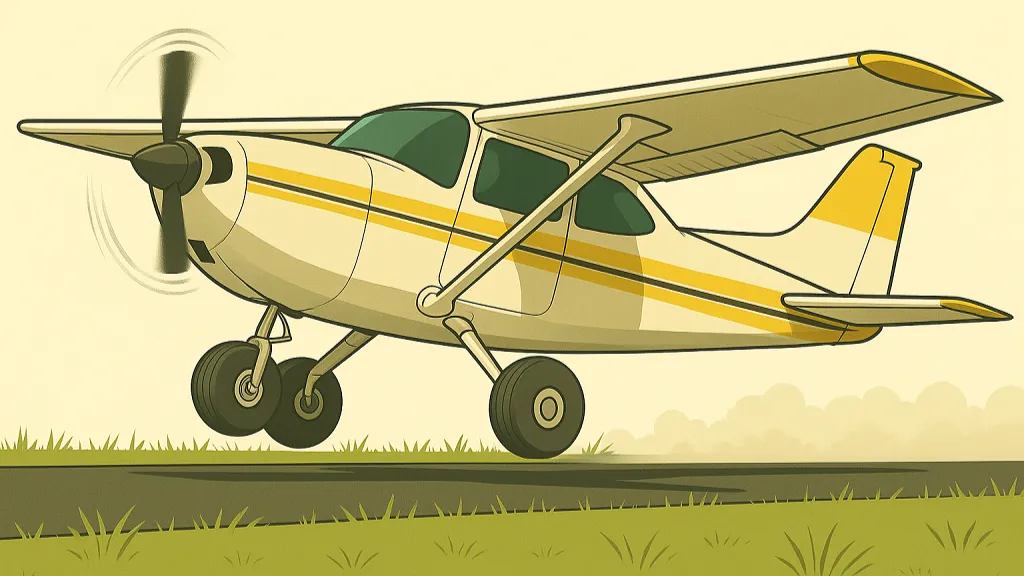
Simulated Soft Field on Pavement: Practice the approach configuration, sight picture, and flare as if the pavement were a soft field. This hones the precision needed for the real thing.
Progressive Challenges: Begin with larger grass fields, gradually moving to smaller, more challenging strips as you improve. This measured approach builds confidence and reduces risks.
Focus on Fundamentals: In every session, concentrate on key elements: correct approach speed, precise power management, and smooth, controlled flares. Consistent attention to these fundamentals builds mastery.
You might also be interested in: Top 19 Aviation Safety Tips for Pilots
Overcoming Learning Plateaus
Almost everyone hits plateaus. If you feel stuck, reassess your technique with your CFI. A fresh perspective can reveal subtle errors hindering progress. This objective analysis can reignite your learning.
Video recording landings can also be incredibly helpful. Reviewing footage allows you to objectively analyze your performance, spotting areas for improvement that might be missed in flight. For example, you might notice a tendency to over-control during rollout.
The Role of Flight Simulation
Flight simulation can supplement real-world training. It provides a safe space to practice procedures and refine techniques, particularly for unusual situations. However, simulation doesn’t replicate the real-world feel of a soft field landing.
Simulators are especially helpful for practicing emergencies or challenging conditions like soft field crosswind landings. This builds confidence for unexpected situations. While valuable, simulators can’t replace the feel of an aircraft responding to a soft surface. These physical sensations are key for true proficiency. So, use simulation as a tool, but prioritize real-world practice with a qualified CFI.
When Things Don’t Go As Planned
Real-world soft field landings often present unexpected challenges. This section prepares you for surprises, from sudden wind shifts to unexpected surface conditions. It’s all about adapting your approach and making sound decisions when conditions change, essentially developing your “Plan B.”
Handling Crosswinds and Obstacles
Crosswinds significantly complicate soft field landings. Maintaining alignment and control requires precise rudder inputs, much like making constant corrections when landing a small boat on a choppy lake.
Obstacles like trees or fences add another layer of complexity, demanding careful energy management. You need enough power to clear the obstacle but a slow enough speed for touchdown. This balancing act requires precise control of your aircraft’s speed and descent rate.
Crosswind Approaches: Crab into the wind to maintain runway alignment, transitioning to a wing-low attitude just before touchdown. Mastering this technique takes practice, similar to learning to ride a bicycle.
Obstacle Clearance: Calculate the necessary power setting to clear obstacles while maintaining a safe approach speed. This involves understanding your aircraft’s performance capabilities.
Adjusting to Changing Conditions: Be ready to adapt your approach if conditions change suddenly. A sudden gust of wind, for example, might require adding power to maintain control.
The Go-Around Decision: Knowing When to Abort
Executing a go-around from a soft field can be tricky. The softer surface reduces acceleration, demanding a decisive application of power and a careful climb-out path. This quick action can prevent a potentially dangerous situation.
Recognizing when to abort is crucial. Key warning signs include:
Unstable Approach: If your approach isn’t stable, a go-around is safer than risking a poorly executed landing.
Unexpected Obstacles: If you encounter an unforeseen hazard, a go-around is the best option.
Deteriorating Surface Conditions: If the runway is softer than expected, aborting the landing is a wise decision.
Sudden Wind Shifts: Strong, unexpected gusts can destabilize your approach, making a go-around the prudent choice.
Recovery Techniques: When Things Go Sideways
Even with the best planning, things can still go wrong. A sudden gust of wind or an unexpected soft spot can create a difficult situation. This is where recovery techniques are essential.
Ballooning: If you float above the runway due to excess speed or a late flare, smoothly reduce power to settle back down. Avoid abrupt control inputs, which can destabilize the aircraft.
Porpoising: If the aircraft starts bouncing on the soft surface, maintain steady back pressure on the control column and add a small amount of power to dampen the oscillations.
Wing Drop: If a wing drops unexpectedly, apply aileron and rudder input to level the wings and maintain directional control.
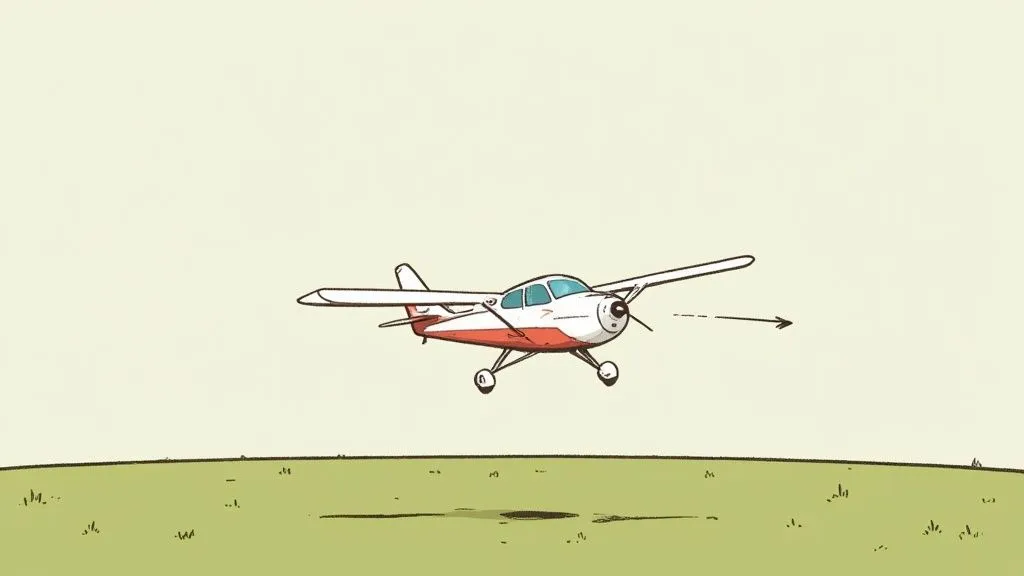
Developing sound judgment is key for safe soft field operations, especially in less-than-ideal conditions. This involves assessing risk, anticipating potential problems, and making informed decisions under pressure, much like a chess player thinking several moves ahead.
Learning these advanced techniques and recovery strategies means that you can approach soft field landings with increased confidence and be prepared for unexpected challenges. This proactive approach enhances safety and makes you a more proficient pilot.
Key Takeaways
Your practical action plan for implementing soft field landing skills begins now. This summary consolidates essential techniques into actionable guidelines, including checklists, warning signs, and benchmarks for tracking progress. We’ll also explore practice schedules, resources for continued learning, and guidance on seeking further instruction. Each takeaway focuses on building real-world skills, expanding your opportunities while enhancing safety.
Essential Checklists and Warning Signs
Before attempting a soft field landing, review this checklist. It highlights critical items for safe operation. A thorough pre-flight check and a stable approach are just as important as a smooth touchdown and rollout.
Soft Field Landing Safety Checklist
| Phase | Critical Items | Safety Considerations | Go/No-Go Criteria |
|---|---|---|---|
| Pre-Flight | Check field conditions, wind direction/speed | Note any obstacles, uneven terrain, or soft spots | Field unsuitable if conditions don’t match your aircraft’s capability |
| Approach | Stable approach speed, full flaps (usually) | Maintain proper sight picture, be prepared for wind gusts | Unstable approach – GO AROUND |
| Touchdown | Maintain back pressure, nose wheel slightly up | Minimize impact, avoid excessive braking | Excessive sink rate or hard landing – consider go-around |
| Rollout | Gentle braking, maintain directional control | Reduced braking effectiveness on soft surfaces | Loss of directional control – apply appropriate corrective action |
| Post-Landing | Clear runway promptly | Be mindful of other aircraft, taxi slowly and carefully | Obstructions on taxiway – request assistance if necessary |
Recognizing unsafe conditions is also crucial. Be alert for these warning signs:
Standing water or excessively muddy areas: These indicate very soft ground, potentially exceeding your aircraft’s capability.
Deep ruts or holes: These pose a risk of landing gear damage and potential loss of control.
Obstacles on the rollout path: Ensure a clear rollout path, considering field length and braking effectiveness on the soft surface.
Unfavorable wind conditions: Strong, gusty crosswinds increase landing complexity, especially on a soft field.
Building Proficiency: Practice and Resources
Practice is paramount for mastering soft field landings. Follow these steps for a structured approach:
Start with Dual Instruction: Initial training with a qualified Certified Flight Instructor (CFI) provides personalized guidance. Focus on fundamentals and refine your technique under expert supervision.
Practice on Varied Surfaces: Combine actual grass strip landings with simulated soft field approaches on paved runways. This reinforces the necessary sight picture and control inputs.
Set Realistic Benchmarks: Gradual progression builds confidence. Begin with larger fields and progressively work towards smaller, more challenging strips.
Identify and Correct Weaknesses: Video recordings allow for performance analysis, pinpointing areas for improvement. This objective assessment accelerates learning.
For further learning, consider these valuable resources:
Your Aircraft’s Pilot Operating Handbook (POH): This provides aircraft-specific information on approach speeds, flap settings, and performance limitations.
Online Aviation Communities: Connect with experienced pilots, sharing tips and best practices.
Reputable Aviation Publications: Stay updated on soft field techniques and safety recommendations.
Knowing When to Seek More Help
While practice is essential, recognizing your limits is equally important. If you consistently face challenges with specific aspects of soft field landings, don’t hesitate to seek additional instruction from a CFI. They can diagnose the issue and tailor exercises to address your needs. This personalized feedback can significantly improve your progress and boost your confidence.
Remember, continuous learning is a key characteristic of safe and proficient pilots. Seeking guidance is a sign of strength, demonstrating a commitment to enhancing your skills and prioritizing safety. Investing in your growth as a pilot not only improves your landings but also maximizes your potential and expands your flying opportunities safely.
Recent Posts
FAA MOSAIC Final Rule: What Pilots, Manufacturers, and the Aviation Community Need to Know
Learn how the FAA’s MOSAIC final rule revolutionizes Light-Sport Aircraft certification, expands Sport Pilot privileges, and reshapes general aviation. See what’s changing, when it takes effect,...
Student Pilot Insurance: Essential Coverage for Aspiring Flyers
Discover how student pilot insurance can protect your flying dreams. Get expert tips and coverage options to ensure your safety and peace of mind.


